Kristie Willett’s Research Interests
Throughout my career I have lead research projects which were designed to fundamentally understand the molecular mechanisms underlying toxicity and/or shed light on the potential adverse outcomes due to relevant anthropogenic contamination.
The entire list of our publications can be found at: NCBI Bibliography
Five focus areas of research conducted in my laboratory are highlighted below.
[expand title=”Mechanisms of PAH/BaP toxicity” tag=”h3″] 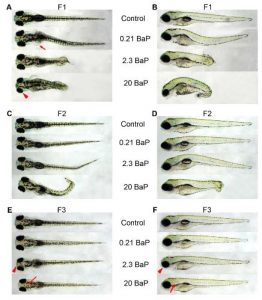
Benzo[a]pyrene (BaP) is a polycyclic aromatic hydrocarbon (PAH) that represents a class of ubiquitous environmental contaminants derived from the incomplete combustion of carbon. Human exposures to PAHs are associated with developmental and reproductive deficits. The goal of this project is to characterize the transcriptomic and epigenetic changes associated with preconceptional exposure to BaP. Specifically, we will determine the role of the aryl hydrocarbon receptor (AhR) in BaP-induced multigenerational phenotypes. The AhR is a ligand activated transcription factor that is critical in regulation of diverse cellular functions from xenobiotic metabolism to cellular proliferation and differentiation. AhR activation is recognized in etiologies for birth defects and embryo lethality. Our central hypothesis is that persistent toxicity of BaP is dependent on the BaP-AhR interaction and AhR activation affects transcriptomic and DNA methylation profiles. To  test this hypothesis, we will use zebrafish, an established model in developmental toxicology, particularly in developmental origins of adult health and disease (DOHaD) research. Importantly, this study will address the NIEHS emphasis areas of environmental epigenetics and developmental basis of adult disease; areas currently lacking appropriate consideration in risk assessment.
test this hypothesis, we will use zebrafish, an established model in developmental toxicology, particularly in developmental origins of adult health and disease (DOHaD) research. Importantly, this study will address the NIEHS emphasis areas of environmental epigenetics and developmental basis of adult disease; areas currently lacking appropriate consideration in risk assessment.
[/expand]
[expand title=”Drug-resistant epilepsy: Efficacy vs toxicity of cannabidiol and Δ9-tetrahydrocannabinol” tag=”h3″]
The goal of this project is to compare the relative morphological, behavioral, reproductive and multigenerational phenotypes that result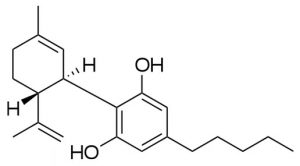 after developmental exposures to cannabidiol (CBD) and Δ9- tetrahydrocannabinol (THC). Due to relaxed prohibitions on marijuana use and therapeutic potential of cannabis constituents in the treatment of early-onset pharmaco-resistant epilepsy, exposure of children to these chemicals is increasing. CBD/Epidiolex is now legal for drug-resistant epilepsy. While CBD shows anecdotal efficacy in reducing seizure frequency, little is known about the potential adverse side-effects of cannabinoids on child physiology, brain development, adult disease, and/or F1 offspring. In this study we will leverage the advantages of the zebrafish model including high fecundity, low culture costs, transparent and conserved developmental biology and genomics. We will comprehensively assess phenotypic alterations caused by two developmental exposures (either during organogenesis or sexual differentiation) and mechanistically link the adverse outcomes with targeted and global transcriptomic analyses. This research will address the significant knowledge gap that exists related to adult and multigenerational behavioral and reproductive consequences of early life cannabinoid exposure. Importantly, this proposed project addresses the NIH emphasis on understanding the functional consequences of cannabis and cannabinoid exposures on the developing brain.
after developmental exposures to cannabidiol (CBD) and Δ9- tetrahydrocannabinol (THC). Due to relaxed prohibitions on marijuana use and therapeutic potential of cannabis constituents in the treatment of early-onset pharmaco-resistant epilepsy, exposure of children to these chemicals is increasing. CBD/Epidiolex is now legal for drug-resistant epilepsy. While CBD shows anecdotal efficacy in reducing seizure frequency, little is known about the potential adverse side-effects of cannabinoids on child physiology, brain development, adult disease, and/or F1 offspring. In this study we will leverage the advantages of the zebrafish model including high fecundity, low culture costs, transparent and conserved developmental biology and genomics. We will comprehensively assess phenotypic alterations caused by two developmental exposures (either during organogenesis or sexual differentiation) and mechanistically link the adverse outcomes with targeted and global transcriptomic analyses. This research will address the significant knowledge gap that exists related to adult and multigenerational behavioral and reproductive consequences of early life cannabinoid exposure. Importantly, this proposed project addresses the NIH emphasis on understanding the functional consequences of cannabis and cannabinoid exposures on the developing brain.
[/expand]
[expand title=”Detection and Prevention of Lead Exposure through Community Engaged Research and Action in Mississippi” tag=”h3″]
Lead is a potent neurotoxicant that causes persistent neurocognitive defects. Children’s neurodevelopment is particularly susceptible,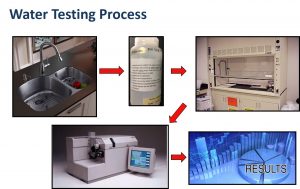 and thus, there is no safe level of lead exposure. Concentrations of lead in the general population have been decreasing as a result of policy and public health changes associated with banning leaded paint and gas. Yet, drinking water is an underappreciated source of lead exposure in some communities. This project is the genesis of community-university partnerships that have coalesced around the issue of lead-contaminated drinking water in Mississippi. Our multidisciplinary team has expertise in toxicology, law, sociology, engineering, and clinical, translational, and big data science, combined with our network of engaged community partners. Mississippi ranks 18th among states for lead poisoning even when less than 20% of youth are tested for elevated blood lead levels (EBLL). Our team is studying the underlying causes for undertesting, conduct continuing education, and assess programmatic success toward achieving our long-term impact of increased BLL testing. Secondly, there is a recent history of drinking water samples with lead concentrations exceeding the 15 ppb action level in our focus communities (Jackson and the Delta areas). We help facilitate community testing events to empower residents with the knowledge to make informed decisions related to minimizing their family’s lead exposure. Our goal is to support changes to prevent or reduce exposure to harmful environmental contaminants and improve health outcomes in Mississippi communities.
and thus, there is no safe level of lead exposure. Concentrations of lead in the general population have been decreasing as a result of policy and public health changes associated with banning leaded paint and gas. Yet, drinking water is an underappreciated source of lead exposure in some communities. This project is the genesis of community-university partnerships that have coalesced around the issue of lead-contaminated drinking water in Mississippi. Our multidisciplinary team has expertise in toxicology, law, sociology, engineering, and clinical, translational, and big data science, combined with our network of engaged community partners. Mississippi ranks 18th among states for lead poisoning even when less than 20% of youth are tested for elevated blood lead levels (EBLL). Our team is studying the underlying causes for undertesting, conduct continuing education, and assess programmatic success toward achieving our long-term impact of increased BLL testing. Secondly, there is a recent history of drinking water samples with lead concentrations exceeding the 15 ppb action level in our focus communities (Jackson and the Delta areas). We help facilitate community testing events to empower residents with the knowledge to make informed decisions related to minimizing their family’s lead exposure. Our goal is to support changes to prevent or reduce exposure to harmful environmental contaminants and improve health outcomes in Mississippi communities.
Story Map of Water Quality Challenges in Jackson, Mississippi
[/expand]
[expand title=”Quantitation of environmental impacts of regional natural and anthropogenic disasters” tag=”h3″]
As the only environmental toxicology graduate program in Mississippi, we take seriously our role to help provide the best science in the wake of disasters like Hurricane Katrina and the Deep Water Horizon Oil Spill. Accordingly we have routine monitoring locations along the MS-AL coasts wherein we have done chemical and bioassay assessments for PAH, inorganic and endocrine disrupting contaminants. An undergraduate honors student working together with the chemistry department measured and calculated ingestion risks associated with mercury contaminated local fish intake. Former students involved in these projects are now working for example with the Tennessee and Mississippi Departments of Environmental Quality, further shaping our regional environmental policies.
disasters like Hurricane Katrina and the Deep Water Horizon Oil Spill. Accordingly we have routine monitoring locations along the MS-AL coasts wherein we have done chemical and bioassay assessments for PAH, inorganic and endocrine disrupting contaminants. An undergraduate honors student working together with the chemistry department measured and calculated ingestion risks associated with mercury contaminated local fish intake. Former students involved in these projects are now working for example with the Tennessee and Mississippi Departments of Environmental Quality, further shaping our regional environmental policies.
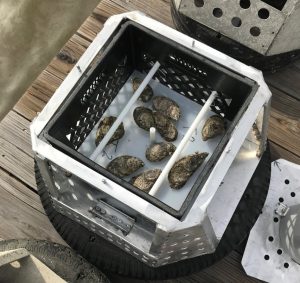
Ongoing research includes a CORE Research Program funded by MBRACE, Mississippi Based RESTORE Act Center of Excellence. The goal of this project is to identify differences in abiotic and biotic stressors at current and historic oyster reef sites, to better understand oyster reef health and to inform management regarding the best places and practices to improve oyster reef restoration strategies. To address this goal, The University of Mississippi researchers will undertake three interdisciplinary objectives. They will: 1) develop and deploy replicate Oyster Sensor Platforms to current and historic oyster reefs, 2) characterize the biochemical and physiological responses of oysters to natural and anthropogenic stressors at these sites, and 3) assess the ecological and environmental impacts of stress on oyster reefs.
[/expand]
[expand title=”Using zebrafish breast cancer xenotransplantation models for natural product drug discovery” tag=”h3″]
There is a need to develop in vivo systems for high throughput screening of anti-cancer compounds because the traditional model 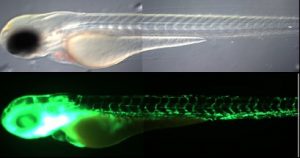 (mouse) is slow to develop tumors after xenotransplantation, less amenable for high throughput screening, and expensive to maintain. Zebrafish offer unique advantages as an animal model because they develop rapidly and can be xenotransplanted with human cancer cells and exhibit similar gene expression as humans. Using transparent transgenic zebrafish embryos with fluorescent vasculature, the metastases of the labelled tumor cells can be tracked and the effects of anti-cancer compounds on the tumor cells can be observed. Leads with the highest efficacy and safety are then targeted for additional evaluation of mechanisms of action.
(mouse) is slow to develop tumors after xenotransplantation, less amenable for high throughput screening, and expensive to maintain. Zebrafish offer unique advantages as an animal model because they develop rapidly and can be xenotransplanted with human cancer cells and exhibit similar gene expression as humans. Using transparent transgenic zebrafish embryos with fluorescent vasculature, the metastases of the labelled tumor cells can be tracked and the effects of anti-cancer compounds on the tumor cells can be observed. Leads with the highest efficacy and safety are then targeted for additional evaluation of mechanisms of action.
[/expand]
[expand title=”COBRE Phase III Pilot Project Program Applications Now Accepted” tag=”h3″]
The Center of Research Excellence in Natural Products Neuroscience (CORE-NPN) supports a formal mentoring program to promote the establishment of independent research programs for investigators. All investigators receive bridge funding ($50,000 per year for maximum two years) to support their research. The investigators are required to submit a competitive R01 grant application to NIH within two years of receiving support through this program. Dr. Willett serves at PI of the Pilot Project Program.
[/expand]
